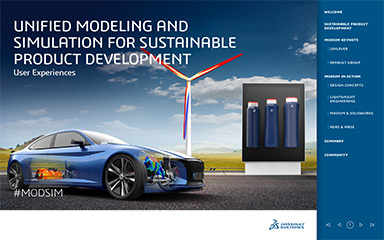
ETA’s Accelerated Concept to Product Process includes design, development and CAE analysis that can reduce both cost and development time. Image courtesy of ETA.
Latest News
May 1, 2017
Designers and engineers are under increasing pressure to deliver better designs faster to bring products to market at an accelerated pace. Many firms have begun implementing design exploration and optimization processes earlier in the process that rely on more frequent simulation.
That transition has been enabled by the availability of lower-cost high-performance computing hardware, cloud-based HPC and simulation services, more powerful workstations, easier to use simulation tools and simulation functionality that is embedded in some CAD programs. By performing simulations during the design process, the designs are improved and there is less of a bottleneck caused by a shortage of simulation experts and analysts.
 ETA’s Accelerated Concept to Product Process includes design, development and CAE analysis that can reduce both cost and development time. Image courtesy of ETA.
ETA’s Accelerated Concept to Product Process includes design, development and CAE analysis that can reduce both cost and development time. Image courtesy of ETA.In the testing phase, simulation has also helped drive down the cost and time required for prototyping and physical testing. “Companies are spending more money to do a lot of virtual testing and advanced product design and development before testing,” says Akbar Farahani, vice president of global engineering at Engineering Technology Associates (ETA) in Detroit. The company provides product design and development services for the automotive and ground transportation industry. “That’s because of the confidence people have in the virtual testing to reduce the cost of product design and prototyping.”
However, smaller and mid-sized firms often can’t afford computational fluid dynamics, computing clusters, high-performance computing (HPC) systems and the other tools necessary to perform rapid simulations. For companies that design lower-cost consumer goods, the business case for simulation may be unclear because prototypes and physical testing are relatively inexpensive.
Accelerating Development
Other benefits to simulation, however, go beyond prototyping/testing cost. The viability of lower cost items, particularly consumer goods, is often driven by time to market. Long delays can adversely affect competitive advantage and make it difficult to recoup development costs.
Design optimization and innovation then become of paramount importance. Advanced simulation can help reduce the time and cost of trials and experiments. It also makes it easier to optimize and troubleshoot designs without the time or cost associated with physical prototypes.
Using simulation in advance of physical testing, designers can render, visualize, analyze and discard various designs or iterations before any prototypes need to be built. Smaller companies can take advantage of third-party simulation/testing services that can help them with this process without the expense of investing in new hardware or software.
This can generate significant cost savings and provide a faster time to market for new products.
“There’s no substitute for testing, but it can be more expensive and more time-consuming than running a simulation,” says Gary Delserro, president of Delserro Engineering Solutions. “If you study and understand how to design the product right the first time, it will reduce that test time and cost.
“If you test something and it fails, you might spend a week setting it up and a week testing it, and then you have to go back and do a failure analysis,” Delserro adds. “You can spend three or four weeks on a program like that. If you had done some accurate simulation up front, you could have found that problem in less than a week, so you’d have significant time savings.”
Ultimately that can result in faster product development. According to Farahani, ETA has created a software and services package the company calls its Accelerated Concept to Product Process that includes design, development and CAE analysis that can reduce both cost and development time. “It’s an extensive process, and applies our expertise and knowledge to every aspect of cost reduction for the customer,” says Farahani.
Simulation also makes it easier to build up a knowledge store based on the results of those virtual tests that can guide future designs.
Simulation for Designers
In the past, simulation created bottlenecks because multiple designers were handing their work to a small number of analysts for validation. If there was a flaw in the design, the turnaround time could run into weeks to correct the issue and then have another analysis run.
Software companies are making it easier for engineers and designers to manage simulations earlier in the process, and do so with easier to use tools. There are simulation tools integrated into CAD packages, simulation apps, engineer-friendly wizards and smart templates, and industry-specific solutions. SOLIDWORKS, Autodesk, Siemens and PTC, for example, have all gone this route.
There are also custom app-building tools that analysts can use to create interfaces for designers on an ad hoc basis. Smaller companies can benefit from new pricing schemes offered by these providers, including tiered pricing and subscription-based cloud offerings.
There are other options as well. ANSYS, for example, offers a startup program for smaller companies that provides low-cost or free access to its simulation tools. SimScale offers a similar program with a low monthly subscription fee for eligible small businesses that includes support from a company consultant and training.
With lower cost tools and services that are created with designers in mind, smaller firms can leverage simulation to validate their designs. This can provide a return on investment, even for relatively inexpensive products, because the time savings can add so much value to the process.
Getting Started
Effectively using simulation—either internally or via a third-party service provider—requires some preparation. Designers should understand the engineering problem they are trying to solve and should have enough expertise to interpret the simulation results.
If you are working with a testing/simulation company, make sure to fully vet the company prior to signing a contract. Many of these companies specialize in particular industries or product categories (aviation, automotive, plastics, consumer electronics and so on), so they should have experience with the types of products you need tested as well as the proper certifications. “Be careful that the company you work with has a track record in your industry and check their references,” Delserro says. “If you haven’t got any experience in simulation, it can be worth it to have someone who knows what they are doing to handle those first projects.”
Designers also need to have the right data available in order to successfully complete these simulations or take their projects to third-party providers. “The challenge is always to request the right information,” Farahani says.
Without that data, it will be difficult to validate the results of the simulation and move forward with a viable design.
Having the correct materials information and specifications is another stumbling block, particularly when it comes to composites and other materials that have comparatively little available testing data. “The new materials are very difficult to work with in terms of simulation because the confidence is still not 100% there,” Farahani says. “The computer doesn’t have any understanding of what that material behavior is, especially with composite and other variations. Defining that and providing that in the virtual environment is a challenge. You have to have the right material characteristics to do better simulations.”
Simulation and modeling solution vendors are striving to extend the reach of their products to smaller companies and less expensive classes of products. The advantage to using simulation in advance of, and in conjunction with, physical testing lies in lower costs and a faster development process—critical advantages in today’s faster paced and highly competitive markets.
More Info
Delserro Engineering Solutions
Subscribe to our FREE magazine, FREE email newsletters or both!
Latest News
About the Author
Brian Albright is the editorial director of Digital Engineering. Contact him at de-editors@digitaleng.news.
Follow DE





